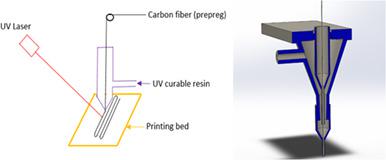当前位置:
X-MOL 学术
›
Polym. Compos.
›
论文详情
Our official English website, www.x-mol.net, welcomes your feedback! (Note: you will need to create a separate account there.)
3D printing of continuous carbon fiber reinforced thermoset composites using UV curable resin
Polymer Composites ( IF 5.2 ) Pub Date : 2021-08-19 , DOI: 10.1002/pc.26266 Md Atikur Rahman 1 , Md Zahirul Islam 1 , Luke Gibbon 1 , Chad A. Ulven 1 , John J. La Scala 2
Polymer Composites ( IF 5.2 ) Pub Date : 2021-08-19 , DOI: 10.1002/pc.26266 Md Atikur Rahman 1 , Md Zahirul Islam 1 , Luke Gibbon 1 , Chad A. Ulven 1 , John J. La Scala 2
Affiliation

|
Additive manufacturing is trending toward functional applications beyond the scope of rapid prototyping. This requires the development of high-performance, lightweight, and complex structures resulting from additive manufacturing. One of the biggest challenges for fulfilling these requirements is the limitation of material properties. The introduction of reinforcement allows for the expansion of current polymer-based 3D printing technologies to achieve increased material properties while maintaining complex geometries. Commercial 3D printers able to print thermoplastic composites have recently been demonstrated with good repeatability. However, limitations of these thermoplastic composites include low fiber volume fraction and susceptibility to high temperatures. In contrast, thermoset-based composites offer greater thermal stability and higher mechanical performance due to the cross-linked structure of the polymer. Moreover, using continuous reinforcement instead of short fiber reinforcement offers higher performance opportunities. Therefore, the challenge of 3D printing with continuous fiber-reinforced thermoset composite is addressed in this study. A 3D printer capable of printing a UV curable resin system reinforced with continuous carbon fiber was constructed. Variations of printed composites' mechanical properties depending on the fiber tow characteristic were investigated. Two different carbon fiber types and their associated tow twist count and sizing were evaluated in this study. Burn-off tests were used to determine the printed composites' final fiber volume fraction. Using a rule of mixtures approach, strength and modulus were predicted for each composite and compared against their experimental values. Predicted modulus values were found within 2%–5% of experimental, while strength values were significantly less than predicted.
中文翻译:

使用紫外线固化树脂 3D 打印连续碳纤维增强热固性复合材料
增材制造正趋向于超越快速原型制作范围的功能性应用。这需要开发由增材制造产生的高性能、轻量级和复杂的结构。满足这些要求的最大挑战之一是材料特性的限制。增强材料的引入允许扩展当前基于聚合物的 3D 打印技术,以在保持复杂几何形状的同时提高材料性能。能够打印热塑性复合材料的商用 3D 打印机最近已被证明具有良好的可重复性。然而,这些热塑性复合材料的局限性包括纤维体积分数低和对高温的敏感性。相比之下,由于聚合物的交联结构,热固性复合材料具有更高的热稳定性和更高的机械性能。此外,使用连续增强材料代替短纤维增强材料可提供更高的性能机会。因此,本研究解决了使用连续纤维增强热固性复合材料进行 3D 打印的挑战。构建了能够打印用连续碳纤维增强的 UV 固化树脂系统的 3D 打印机。研究了打印复合材料机械性能随纤维丝束特性的变化。本研究评估了两种不同的碳纤维类型及其相关的丝束捻度和浆纱。燃烧测试用于确定打印复合材料的最终纤维体积分数。使用混合法则,预测每种复合材料的强度和模量,并与它们的实验值进行比较。预测的模量值在实验的 2% 到 5% 之间,而强度值明显低于预测值。
更新日期:2021-08-19
中文翻译:

使用紫外线固化树脂 3D 打印连续碳纤维增强热固性复合材料
增材制造正趋向于超越快速原型制作范围的功能性应用。这需要开发由增材制造产生的高性能、轻量级和复杂的结构。满足这些要求的最大挑战之一是材料特性的限制。增强材料的引入允许扩展当前基于聚合物的 3D 打印技术,以在保持复杂几何形状的同时提高材料性能。能够打印热塑性复合材料的商用 3D 打印机最近已被证明具有良好的可重复性。然而,这些热塑性复合材料的局限性包括纤维体积分数低和对高温的敏感性。相比之下,由于聚合物的交联结构,热固性复合材料具有更高的热稳定性和更高的机械性能。此外,使用连续增强材料代替短纤维增强材料可提供更高的性能机会。因此,本研究解决了使用连续纤维增强热固性复合材料进行 3D 打印的挑战。构建了能够打印用连续碳纤维增强的 UV 固化树脂系统的 3D 打印机。研究了打印复合材料机械性能随纤维丝束特性的变化。本研究评估了两种不同的碳纤维类型及其相关的丝束捻度和浆纱。燃烧测试用于确定打印复合材料的最终纤维体积分数。使用混合法则,预测每种复合材料的强度和模量,并与它们的实验值进行比较。预测的模量值在实验的 2% 到 5% 之间,而强度值明显低于预测值。



























 京公网安备 11010802027423号
京公网安备 11010802027423号